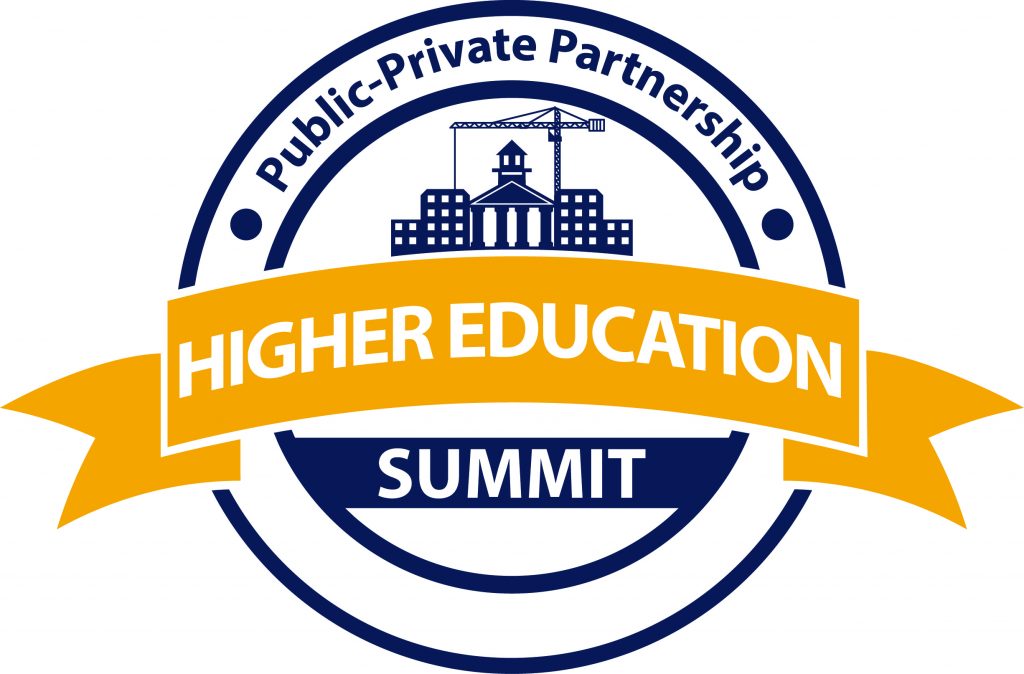
Program
Delivering Campus Infrastructure Through Partnerships

The Summit program presents a series of keynotes, case studies, panels, workshops, and diverse networking opportunities designed for attendees to deepen their understanding on alternative project models, innovations in project delivery, the value proposition of P3s, and the role they can play in the delivery of essential campus infrastructure.
Our agenda has been programmed to help you plan and procure successful projects, understand best practices in selecting and negotiating with prospective partners, and steps to take to ensure project success.
Leading practitioners will present their firsthand observations of higher education P3 projects of all sizes in different markets around the country. We will also offer in-depth roundtable discussions for delegates with interest in discussing specific P3 issues in a more candid and interactive forum.
With over 750 participating delegates, attendees find the Summit to be one of the most effective places on their event schedule to cultivate relationships and network with the industry’s most active and influential professionals.
2025 Program

The Summit agenda features a broad range of topics specifically tailored to the needs of higher education institutions evaluating P3s. This program will share examples of where P3s can be applicable; and how they can save money and time when dealing with upgrades, repairs, and maintenance.
The agenda offers numerous case studies (big, medium and small examples of successful and unsuccessful projects) of how P3s can work. We will also provide a perspective on current P3 activities in the market and update on P3’s in progress including their challenges and successes.
The agenda takes a clear look at current trends in P3s, while examining contract structures, facility types, and financing mechanisms in use. Through conversations with owners, developers, operators, and advisers, the Summit explores best practices and lessons learned from successful partnerships.
P3 Fundamental Topics
A list of best practices and lessons learned will be presented, including:
Pre-Award Discussion Topics:
- Assessing the feasibility of a P3 project – what type of projects are best served by P3s
- Steps to take to ensure your procurement process is setup for success
- Identifying the merits and risks of P3 structures
- Options for small and medium size universities seeking partnerships
- Defining project requirements and identifying appropriate project delivery models
- How to score, select, and negotiate with prospective partners
- Common pitfalls in P3 transactions
- Understanding the potential credit impacts P3s can have on rating and debt capacity
- Political considerations for developing and implementing P3 projects
- The role of a political or internal champion in building P3 partnerships
- Coordinating internal and external stakeholders to optimize P3 delivery
- Hidden costs and overlooked risks
- How have P3 projects failed and what are the lessons learned
- Why aren’t P3s or alternative delivery mechanisms more commonly used in the US market?
Team Work and Collaboration Discussion Topics:
- The importance of early engagement with private partners
- The benefits of P3 beyond financing
- Integration tools and techniques that enhance collaboration
- Owner roles/responsibilities in executing a P3
- Risk balance and expectation management
- Stakeholder management
- Communication strategies – how to win political and local support with successful communication plans
Advanced Project Delivery Discussion Topics:
- Aligning Owner and Developer perspectives
- Contract administration
- Risk identification, mitigation, and tradeoff strategies
- Asset monetization of non-core infrastructure assets using P3s
- Financing solutions and value propositions under the P3 Model
- The influence of design within the P3 process
- Value creation from transferring operations and maintenance
- International models under P3
- Incorporating new technologies into P3 projects to enhance revenue
- Latest innovations and life-cycle efficiencies in P3 delivery
We’re always working with the industry’s top thought-leaders to build our program. If you have interest in participating, please contact Sarah Zinn at szinn@accessintel.com.
Featured Sessions

To P3 or Not To P3: How To Determine the Appropriate Project Delivery Model?
How are schools determining the optimal delivery model for their projects? Not every project can or should be delivered as a P3. Before initiating procurement for a P3 project, owners must undertake a business case analysis to determine whether a P3 is likely to yield higher overall benefit than a more traditional procurement method. Presenters from leading colleges and universities will discuss their pre-procurement methods and explore the applicability of P3 methods to infrastructure projects currently in the pipeline.
Best Practices for a Successful Procurement Process
No question is too simple when starting out. A P3 procurement model is a combination of design, construction, financing, operations, and maintenance. In this panel we discuss the key issues that owners must consider when conducting a project procurement – structuring the agreement, conducting a fair and competitive procurement process, and negotiating a final agreement that is transparent and protects the institution’s interests. Panelists will review best practices and new approaches to procurement in the context of public-private partnerships, and consider how owners can most effectively structure risk transfer in design and construction costs, operational and maintenance challenges, and factors that can impact value for money analysis.
A Template for Instilling Confidence in the Procurement Process
To attract P3 consortium partners (developers, investors, contractors and service professionals), project owners must instill confidence in the procurement process and house the necessary expertise to support a pipeline of P3 projects. This sessions explores how to develop a dedicated institutional framework designed to manage and guide programs and projects.
How Public Schools Can Expand The Pace of Infrastructure Delivery in Light of a Reduced Government Role
What are the options for public schools facing critical infrastructure needs? This session will discuss why you can’t necessarily wait for traditional funding to meet the urgencies created by infrastructure challenges and what are the best ways to move along.
Solutions for Small and Medium Sized Institutions
While the market paces considerable attention on P3 investment opportunities at the largest schools, it’s important not to overlook smaller institutions which can represent attractive opportunities for parties because of the smaller size of a project, the greater cooperation of the institution, and the reduced uncertainty of the transaction. Naturally, investment in these projects also carries its own challenges, including the greater need to educate, the need to assess uncertainties in future enrollment levels, and often the unfamiliarity of the market for these transactions. This session explores – from both the university and the investor’s perspective – how to address the unique hurdles posed by P3 development at small and medium sized institutions. Join us for a discussion that examines what facilities and developments are best suited for P3 development and what strategies should be used.
Financing Solutions Offered In P3s
This session brings together the perspectives of infrastructure banks, state funds, capital market experts, and federal agencies to discuss a range of familiar and lesser known programs available to communities evaluating project investment. Panelists will share insight on the risks and advantages of different options, while considering key issues related to the application process; project selection; leveraging resources; credit analysis; determining leverage; aggregating smaller projects; the role of P3; hybrid funding; implementation; and proper stakeholder coordination. A key objective in this session is to explore ways that these programs can help accelerate and foster increased investment in critical infrastructure in the U.S.
New Strategies for Deferred O&M
P3s can include long-term operations and maintenance obligations that the private sector is responsible for delivering. O&M is mounting challenge faced by schools across the country, and many owners have stated that these operations and maintenance services are one of the biggest reasons for considering a P3. This session will discuss how the inclusion of these key deliverables in a P3 help to maintain infrastructure and improve service quality.
A P3 model for Technologies and Cyber Protections
P3’s have traditionally focused on the delivery of new physical assets or the optimization of existing assets owned by the private sector where innovative technologies and automation provide efficient monetization mechanisms. In an age where new data infrastructures, from broadband towers, fiber backhaul, and last mile connectivity to deliver extremely large data packets at near zero low latency and high reliability are critical to a digital economy and business development, the definition of infrastructure and the P3 delivery model can expanded to include the deployment, operation, and modernization of new technologies, automation, and cybersecurity into the building itself delivered with zero or low initial capital investments and a long term operating agreement with technology vendors.
Using P3 to Transform Energy Management
In the context of an increasing focus on energy cost, volatility, carbon impact and security of supply, facility managers are transforming their energy systems by deploying innovative technical solutions and contracting approaches. These approaches are modernizing aging systems to meet resilience and sustainability objectives, while reducing costs and releasing value. This session discusses examples of good practice and discuss the actions and approaches cities and agencies can take to improve their energy outcomes through P3 type models, drawing upon experts from both the construction and P3 contract management realms.
P3s in Resiliency Projects
Resilience, sustainability, and infrastructure are inextricably linked. Resilience is moving to the top of college and university agendas. Resilience projects encompass a diverse range of infrastructure related matters, from seismic upgrades to reaching carbon neutrality, As the infrastructure need is becoming increasingly apparent, and as funds are ever more constrained, P3 is beginning to emerge as one possible way forward for these key projects. This section will draw on the lessons learned from a number of recent, high profile resilience projects to identify key issues, approaches and themes, which will be relevant to those contemplating similar projects, as well as those involved in structuring complex water related projects. Topics will include an overview of resilience infrastructure, and key drivers for action while considering major challenges faced by resilience projects, as well as the potential roles and limitations of P3 in resilience projects (value proposition, risk, pricing, design innovation etc.). The panel brings a rich perspective from public, university, and private sector leaders in resilience infrastructure.
Soup to Nuts: Delivering Your Project
This session will feature in-depth case studies of projects are being delivered using a variety of approaches leveraging available funds. Panelists will discuss their experiences with planning, procuring and administering contracts. Audience members will learn specific elements of the P3 structures currently in use, and how to evaluate the merits and risks of these structures against other types of P3s and traditional non-P3 development.
The Right Financing Mix: Greenfield vs. Brownfield Developments
What is the optimal financing mix for a P3 project? This discussion considers available financing options for on and off-campus projects involving alternative project delivery. Examining the debt capital structure of certain existing projects, we will focus on variations between project/asset type and development stage (i.e. greenfield v. brownfield). We will consider the reasons for the differ¬ences in the financing mix between projects and whether existing cases present established paradigms or whether alternate structures can be viable on a project-by-project basis. We will also distinguish between such financing when it is put in place by a private developer in a DBFOM procurement and the funding of such costs by the procuring college or university.
Contract Management and Making the Partnership Work
When a P3 contract is signed with a private party, the work of the partnership begins, and both parties have to live up to their responsibilities. Contracts attempt to identify and plan for the potential events that could occur during the life of the P3, but can rarely imagine all events into the future. This module will present the fundamentals and challenges of contract management, methods to streamline documentation. examine P3 contract requirements, discuss enforcement policies, as well as techniques for amending, renegotiating or terminating contracts.
The Case for Project Bundling
P3 bundling is becoming an attractive option for project owners to bring private capital and the benefits of the P3 model to smaller assets. When bundled into a single, larger procurement, a beneficial structure can be implemented to address a group of similar assets across multiple sites, an assortment of different assets at a single site, or different assets across multiple sites. P3 project bundling represents in many cases an opportunity to get more infrastructure built quicker, on budget, and with a higher degree of risk transfer. We’ll discuss how schools can help maximize success by ensuring interests are aligned to deliver quality infrastructure that meets long-term needs. Drawing on the expertise of market participants, the panel will review trends in bundling of infrastructure assets and review conditions for successful bundling – with specific considerations to be made to project sizes, concession length, geography, counter-party quality, and sector class.
Case Study – University of Kentucky Mixed-Use Parking Project
The University of Kentucky has partnered with Signet Real Estate Group to privately deliver a five-story mixed-use facility that will include parking, ground floor retail, technology and innovation-focused educational spaces, and administrative space. This session will focus on the procurement and pre-development stages of the project and will outline how the University approached the partnership with Signet and how the project team arrived at the ideal structure that was advantageous to both UK and Signet. The presenters will cover the following: (1) the reason the University decided a P3 was the best approach for the project; (2) the RFP process and the selection of Signet using the University’s internal TRIPP model, which stands for Term, Return, Investment, Program/Principles and is used to evaluate all P3 opportunities; (3) how the Developer and the University worked collaboratively to evaluate multiple development models before arriving at the current finance and management structure; (4) the University’s ability to be opportunistic as the project progressed, but remain true to the primary project goals; and (5) the University’s multiple project champions and how they lead an efficient internal decision making process that ensures the project maintains the overall timeline.
Case Study – Duquesne University Energy Monetization
In May 2019 Duquesne University closed its utility monetization whereby it contractually transferred its central utility system to Clearway Energy under a 40-year agreement. This transaction is at the forefront of a wave of utility system P3s coming to market and represents an important step forward for the market owing to the location of the Duquesne system that allowed the commercial model to evolve post the Ohio State University utility system monetization. The panel reflects on lessons learned and offers insights for other universities contemplating similar transactions. This panel brings together the key transaction principals and advisors from both the University and Clearway, as well as the rating agency credit perspective, to discuss key transaction motivations, value drivers, risks and key issues resolved to yield a successful transaction. The effective use of the P3 model is predicated on contractually allocating risk to the party most able to effectively manage it, but such risk allocation cannot occur in a vacuum.
Structuring and Financing Options for Higher Ed Projects
In this session we explore various financing structures that have been successful for delivering higher ed projects: comparing the tax-exempt and taxable debt models, equity options, and different loan programs. We also discuss how P3 financing models are evolving and how a traditional project finance program compares to other P3 tools, such as concession agreements, that are more common in other sectors. Panelists will explore what we can we expect regarding future market activity and prospects for both on and off campus developments. Lastly we examine which P3 structure work best for a specific project or to meet the specific goals of an agency, delving specifically into how each structure impacts the project viability, the return to the agency; and its credit profile and balance sheet.
Risk Allocation for Higher Ed Projects
Risk allocation between parties must be aligned with project fundamentals including performance, financing and payment obligations, to ensure that parties are sufficiently incentivized to effectively manage their respective risks once the signed concession agreement becomes effective. This session will offer real world examples, and insights into the critical links between effective risk transfer and incentives impacting both the private partner selection process and the successful implementation of the project concession agreement.
Avoiding Collisions in Sports and Entertainment Projects
What mistakes should the owners avoid when planning and executing a major sports or entertainment facility? What factors contribute to project success – or challenges? How can owners best engage with architects, builders and developers to get projects across the finish line, and what can they learn from sports and entertainment industry experts to avoid common pitfalls? What are the trends in partnerships on these landmark projects? Hear perspectives from the trenches and learn what can make or break your next sports or entertainment project.
Thinking Small – Strategies for Delivering Small and Mid Size Projects
Small and medium size project owners can equally benefit the P3 model, but have they been left out of the P3 market? What are the key success factors that go into smaller sized delivering projects. This session will explore the tools and financing options available to smaller project owners as they evaluate, plan and execute a successful P3 project. Whether upgrading an existing facility, building a new facility or planning for anticipated growth, we review project examples and success factors key to delivering winning projects.
Additional Sessions Include

Critical Linkage between P3s and Economic Development for Community Colleges and Specialty Schools
This panel discussion will explore the unique challenges and educational missions of specialty schools and community colleges to see how public-private partnerships can strengthen their financial standing, reinvigorate students and help the institutions capture economic development opportunities to secure a healthy future. With representatives from industry and institutions, the panel will uncover how and why partnerships are being formed, as well as examine how they will greatly improve the overall academic and student life experiences for members of their community in the short and long-term.
Innovating on Campus: When to Consider P3 for Science and Research Facilities
As science and technology advance at lightning speed, it is increasingly challenging for institutions to offer the cutting edge science and engineering buildings necessary to attract the best and brightest students and faculty. This session focuses on the opportunities and challenges associated with alternative delivery of life sciences, neurosciences, and research facilities. A diverse panel of industry and institutional experts will discuss 1) the impetus for considering a P3 delivery, 2) financing options, 3) development and operating responsibilities of each party, and 4) lessons learned from projects across community college and large public institutions.
New Technologies for Education
EDTECH can provide digital equity, rich learning and instructor opportunities, promote safety, and help boost academic productivity as part of a 21st Century Schools initiative. Increased bandwidth capabilities and in-school data architectures can light up augmented reality (AR) experiences to voice and collaboration technologies, offering flexible virtual learning options and the incorporation of Internet of Things (IoT) technologies and artificial intelligence/machine learning for a better campus experience. Higher education facility/campus developers can bring the private sector expertise of supertechs, Information technology innovators, and smart system manufacturers to the public sector to enhance education. The technologies can be operated, updated, and secured with long term agreements from technology vendors managed through third party service providers.
Top 10 Critical Issues When Procuring a P3
To attract the right P3 consortium partners, owners must instill confidence in the procurement process and house the necessary expertise to support a pipeline of P3 projects. One way to do this is through a dedicated institutional framework designed to manage and guide programs and projects. Join this panel for a step-by-step review of 10 critical issues that must be addressed in a P3. Those issues include Vision, Political Champions, Communication, Community, Commitment, Experience, Funding, Staff, Time, and Access.
Customizing a Project Dashboard – How to Identify your Outcomes and Measure your Results
Key performance indicators are probably the single most important measure when making decisions. But how do we ensure that those measures are shaped by the right indicators, either based on experience or projection – quantitative and qualitative? We will provide thoughtful market context and discuss helpful tools for evaluating P3 projects. Our discussion will focus on what risks need to be monitored, what KPIs the owners and institutions need to keep particularly close track of, and what mechanisms are available to make sure things stay out of the danger zone. Join us for this panel of experienced P3 professionals, and plan to engage in feedback from your experiences.
Understanding Funding vs. Financing and Everything in Between
This session introduces fundamental financial topics related to public-private partnerships. We review how financing models are changing and how a traditional project finance programs compare to other P3 tools, such as concession agreements that are more common in other sectors. Lastly, we examine which P3 structures work best for a specific project or to meet the specific goals of campus, and will delve into how different structure impact project viability, the return to the institution; and credit profiles and balance sheet.
Do We Search for a Development Partner, or Build It Ourselves? Off Campus Infrastructure
When an institution needs a hotel, it faces two options: it can either outsource the task to a private developer who absorbs development risk, contributes equity, and raises debt for the hotel project under a ground lease; or the school can own the hotel, and develop and finance it through the issuance of tax-exempt bonds. This panel will evaluate the pros and cons of each option. In doing so, we will discuss drivers for developing hotels, hotel ground leases, and financing considerations under each of the options.
P3s are Not “All About the Money” – Benefits Beyond Financing
While financing for P3s can be a significant driver, a P3 approach for needed facilities offers more benefits than just financing. When properly structured, P3s can provide project consideration, implementation and operation solutions that add expertise, drive innovation and allocate risk while appropriately balancing levels of control and recognizing the complexity of certain projects. This panel taps into the P3 benefits-beyond-financing for all types of infrastructure assets.
Project Delivery Workshops
Join university and college representatives, owners, industry leaders for breakfast workshops and two days of in-depth interactive workshop conversation specifically tailored to the needs of universities evaluating P3s.
These Summit sessions are designed for those beginning to explore P3s, helping them understand where P3s can be applicable and how they can save money and time when dealing with upgrades and capital improvement plans.
Learn which projects might work best, and what major considerations need to be made once choosing this route, including the first steps.
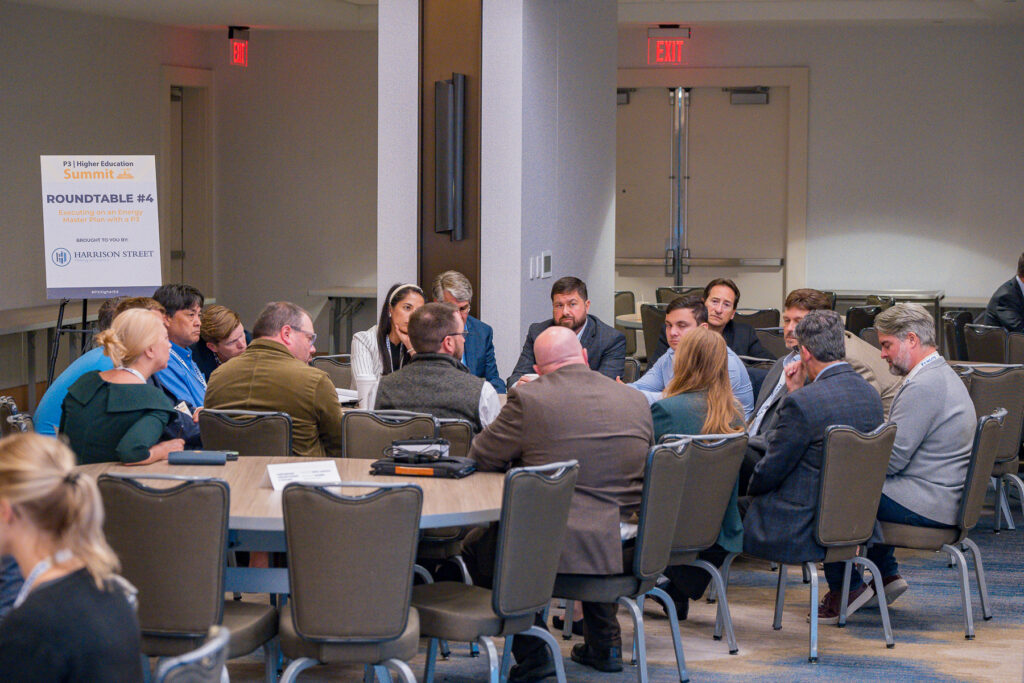
VIEW FROM THE U
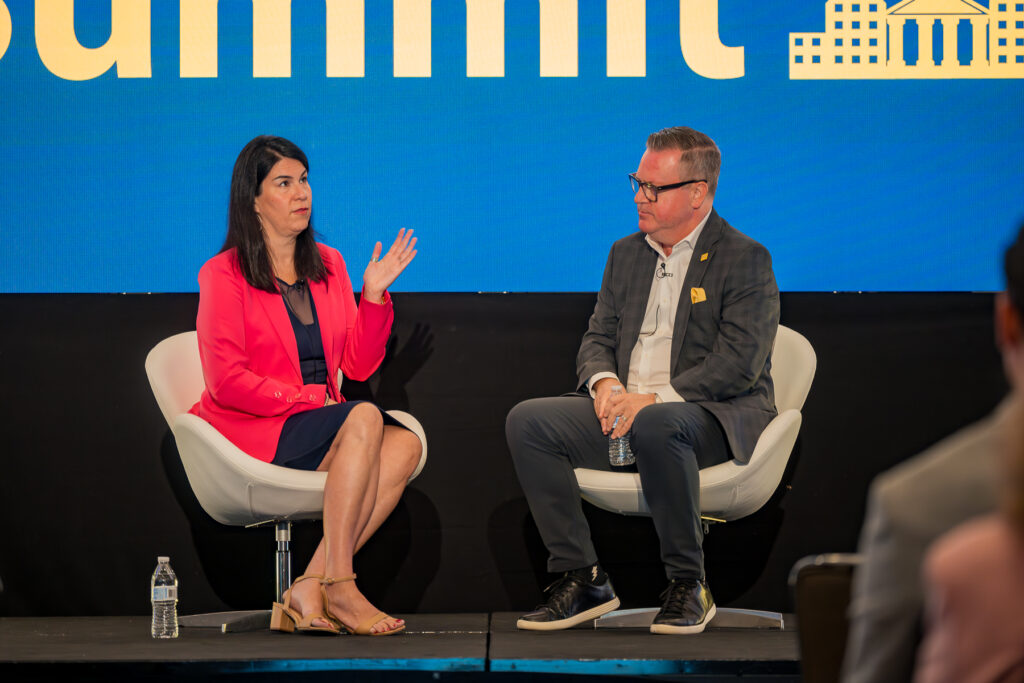
Hear directly from university leaders during our exclusive fireside chats! These conversations will shed light on their major projects, the difficulties they navigate, important lessons learned, and their vision for what lies ahead.
Exhibition Hall
Conference delegates will be able to interact with industry leaders and higher education business and facility officers in a relaxed social setting as well as meet with some of our presenters, sponsors, and event partners.
The exhibition hall is one of our central meeting points for all attendees during the event. Attendees are encouraged to setup one-on-one, pre-scheduled, or private appointments with participants.
If your school or business is interested in hosting a table, please email Brynja Rados for additional details.
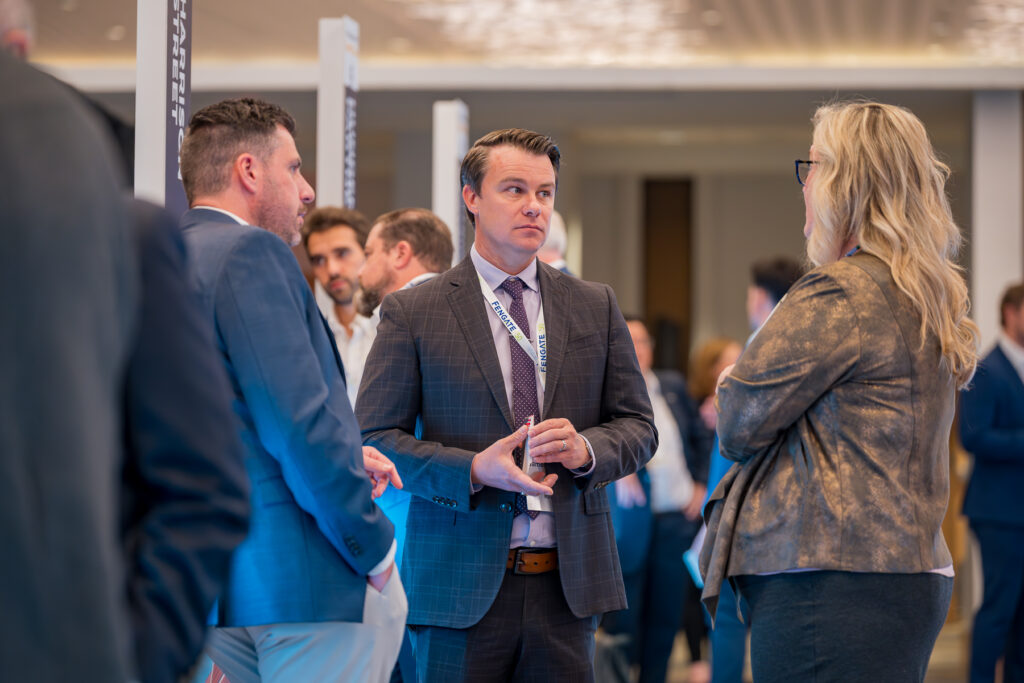
Networking Activities
The event will offer several ways for attendees to network and connect with each other. The program will offer multiple daily breaks, receptions, one-on-one meeting areas and specific events designed for you to meet new industry faces and reconnect with old colleagues.
For our higher education officers, we will be introducing two activities designed to help navigate the intersection of public-private partnerships. Our Higher Education Mentorship Program will explore solutions and techniques for partnering with private developers and public entities to meet increased demands for new and upgraded facilities.
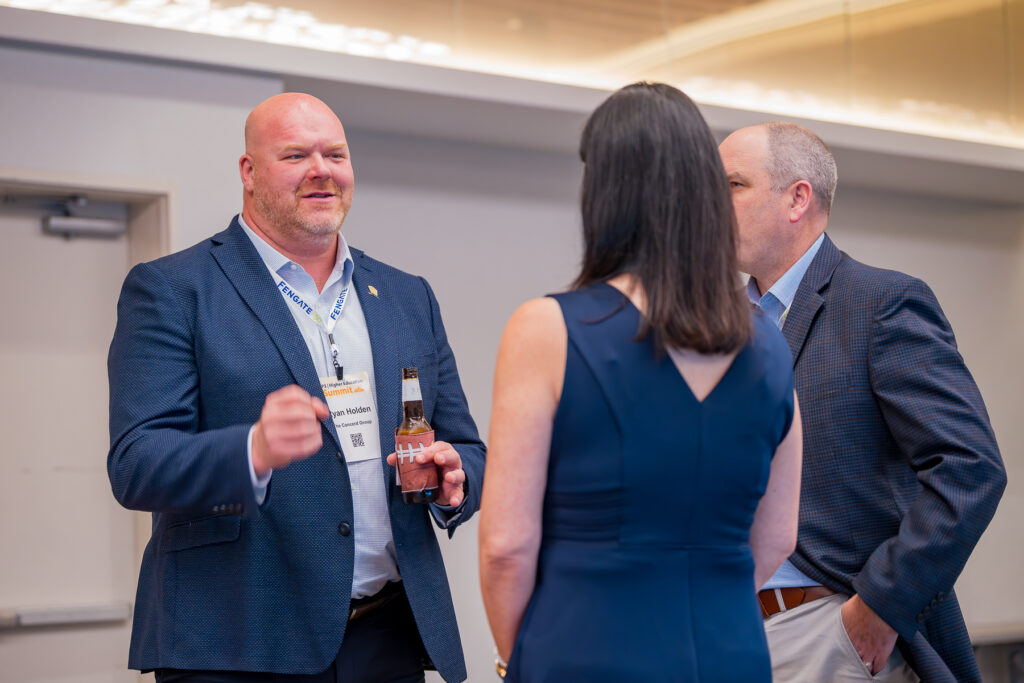
STAY INFORMED | LEARN MORE
Stay up-to-date on industry news, event information, and latest program developments.